非谓语动词doing的用法总结
- 格式:docx
- 大小:36.48 KB
- 文档页数:1

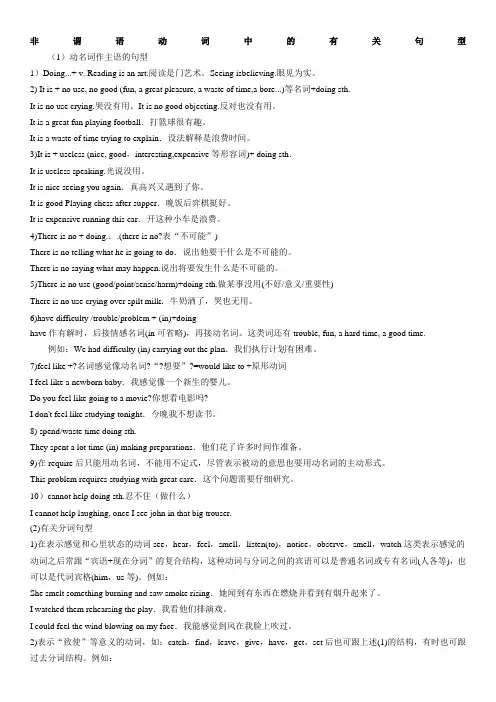
非谓语动词中的有关句型(1)动名词作主语的句型1)Doing...+ v. Reading is an art.阅读是门艺术。
Seeing isbelieving.眼见为实。
2) It is + no use, no good (fun, a great pleasure, a waste of time,a bore...)等名词+doing sth.It is no use crying.哭没有用。
It is no good objecting.反对也没有用。
It is a great fun playing football.打篮球很有趣。
It is a waste of time trying to explain.设法解释是浪费时间。
3)It is + useless (nice, good,interesting,expensive等形容词)+ doing sth.It is useless speaking.光说没用。
It is nice seeing you again.真高兴又遇到了你。
It is good Playing chess after supper.晚饭后弈棋挺好。
It is expensive running this car.开这种小车是浪费。
4)There is no + doing...(there is no?表“不可能”)There is no telling what he is going to do.说出他要干什么是不可能的。
There is no saying what may happen.说出将要发生什么是不可能的。
5)There is no use (good/point/sense/harm)+doing sth.做某事没用(不好/意义/重要性)There is no use crying over spilt milk.牛奶洒了,哭也无用。
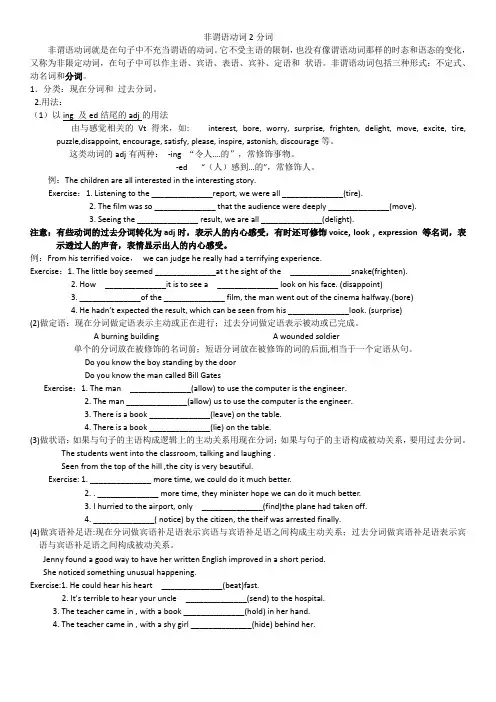
非谓语动词2分词非谓语动词就是在句子中不充当谓语的动词。
它不受主语的限制,也没有像谓语动词那样的时态和语态的变化,又称为非限定动词,在句子中可以作主语、宾语、表语、宾补、定语和状语。
非谓语动词包括三种形式:不定式、动名词和分词。
1.分类:现在分词和过去分词。
2.用法:(1)以ing 及ed结尾的adj的用法由与感觉相关的Vt 得来,如: interest, bore, worry, surprise, frighten, delight, move, excite, tire, puzzle,disappoint, encourage, satisfy, please, inspire, astonish, discourage等。
这类动词的adj有两种:-ing “令人….的”,常修饰事物。
-ed “(人)感到…的”,常修饰人。
例:The children are all interested in the interesting story.Exercise:1. Listening to the ______________report, we were all ______________(tire).2. The film was so ______________ that the audience were deeply ______________(move).3. Seeing the ______________ result, we are all ______________(delight).注意:有些动词的过去分词转化为adj时,表示人的内心感受,有时还可修饰voice, look , expression 等名词,表示透过人的声音,表情显示出人的内心感受。
例:From his terrified voice,we can judge he really had a terrifying experience.Exercise:1. The little boy seemed ______________at t he sight of the ______________snake(frighten).2. How ______________it is to see a ______________ look on his face. (disappoint)3. ______________of the ______________ film, the man went out of the cinema halfway.(bore)4. He hadn’t expected the result, which can be seen from his ______________look. (surprise)(2)做定语:现在分词做定语表示主动或正在进行;过去分词做定语表示被动或已完成。
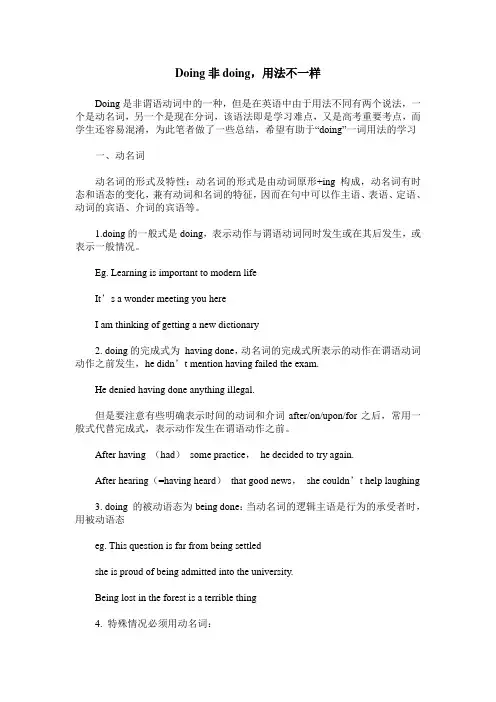
Doing非doing,用法不一样Doing是非谓语动词中的一种,但是在英语中由于用法不同有两个说法,一个是动名词,另一个是现在分词,该语法即是学习难点,又是高考重要考点,而学生还容易混淆,为此笔者做了一些总结,希望有助于“doing”一词用法的学习一、动名词动名词的形式及特性:动名词的形式是由动词原形+ing 构成,动名词有时态和语态的变化,兼有动词和名词的特征,因而在句中可以作主语、表语、定语、动词的宾语、介词的宾语等。
1.doing的一般式是doing,表示动作与谓语动词同时发生或在其后发生,或表示一般情况。
Eg. Learning is important to modern lifeIt’s a wonder meeting you hereI am thinking of getting a new dictionary2. doing的完成式为having done,动名词的完成式所表示的动作在谓语动词动作之前发生,he didn’t mention having failed the exam.He denied having done anything illegal.但是要注意有些明确表示时间的动词和介词after/on/upon/for之后,常用一般式代替完成式,表示动作发生在谓语动作之前。
After having (had)some practice,he decided to try again.After hearing(=having heard)that good news,she couldn’t help laughing3. doing 的被动语态为being done:当动名词的逻辑主语是行为的承受者时,用被动语态eg. This question is far from being settledshe is proud of being admitted into the university.Being lost in the forest is a terrible thing4. 特殊情况必须用动名词:1)动名词做宾语:有些动词或短语动词后常用动名词作宾语。


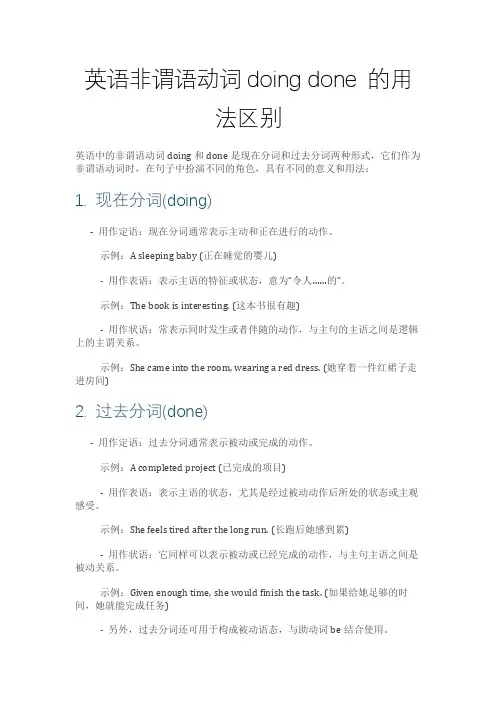
英语非谓语动词doing done 的用法区别英语中的非谓语动词doing和done是现在分词和过去分词两种形式,它们作为非谓语动词时,在句子中扮演不同的角色,具有不同的意义和用法:1. 现在分词(doing)- 用作定语:现在分词通常表示主动和正在进行的动作。
示例:A sleeping baby (正在睡觉的婴儿)- 用作表语:表示主语的特征或状态,意为“令人……的”。
示例:The book is interesting. (这本书很有趣)- 用作状语:常表示同时发生或者伴随的动作,与主句的主语之间是逻辑上的主谓关系。
示例:She came into the room, wearing a red dress. (她穿着一件红裙子走进房间)2. 过去分词(done)- 用作定语:过去分词通常表示被动或完成的动作。
示例:A completed project (已完成的项目)- 用作表语:表示主语的状态,尤其是经过被动动作后所处的状态或主观感受。
示例:She feels tired after the long run. (长跑后她感到累)- 用作状语:它同样可以表示被动或已经完成的动作,与主句主语之间是被动关系。
示例:Given enough time, she would finish the task. (如果给她足够的时间,她就能完成任务)- 另外,过去分词还可用于构成被动语态,与助动词be结合使用。
示例:The homework was finished by the student. (作业被学生完成了) 总结来说,现在分词doing一般表示主动、进行或动态的特征,而过去分词done多表示被动、完成或静态的结果。
在具体应用中,还需结合语境和语法结构来正确使用。
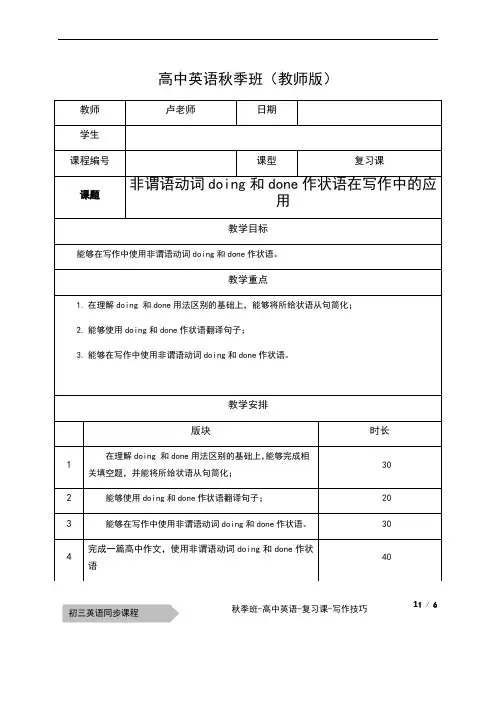
高中英语秋季班(教师版)11 / 6初三英语同步课程秋季班-高中英语-复习课-写作技巧22 / 6初三英语同步课程秋季班-高中英语-复习课-写作技巧v1.0 可编辑可修改33 / 6初三英语同步课程 秋季班-高中英语-复习课-写作技巧一、用动词的适当形式填空:非谓语动词作状语大多相当于一个状语从句A.作时间状语:eg.)①_______ (hear) the bad news, they couldn’t help crying.= _______________, they couldn’t help crying.②When/ While( _____ _____ ) ____ (take) around the city, we were deeply impressed by the city’s new look.While/When (I was) _____ (wander) through the square, I caught sight of a snake-charmer. ③_______ (finish) his work, he went home.=_____________, he went home.B.作原因状语:Eg.) ①_____ (be poor), he could not afford to travel abroad.=____________, he could not afford to travel abroad.________ (encourage) by his heroic deeds, they worked harder._______ (lose) in thought, he almost ran into a post.________ (frighten) by the big forest fire, the animals all ran away._____ (not know) her address, we couldn't get in touch with her.②______ (never be) to the city, he soon got lost._________ (not receive) his letter, I decided to call him up.知识点讲解=_____________.C.方式/伴随状语;Eg.)①She watched the film, _____ (weep ) and ___ (sigh).②The teacher stood there, ______ (surround) by a lot of students.D.作条件状语:Eg.)①______ (give) another chance, I would have done the job far better.=______________ , I would have done the job far better.②(If) _____ (play) all day, you will waste your valuable time.E.作结果状语:(意料中的结果)Eg.)① The hunters fired, _____(shoot) one of the wolves.②The bus was held up by the snowstorm, thus _____ (cause) the delay.区别: 不定式表示意外的结果eg.) He hurried to the station, only ____ (find) the train had left.F.作让步状语:Eg.)①Though ____ (rain) heavily, it cleared up very soon.= _____________, it cleared up very soon.②Though _____ (tell) of the danger, he still risked his life to save the boy.分词作状语时, 需注意事项:A.分词短语作状语时,它的逻辑主语通常应是________ :____ (see) from the hill, the city is beautiful.___ (see) from the hill, you can see the whole city二、使用doing和done简化以下状语从句:44 / 6初三英语同步课程秋季班-高中英语-复习课-写作技巧1.When arriving, send me a telegram. (When you arrive, send me a telegram.) 到达之后,来个电报。
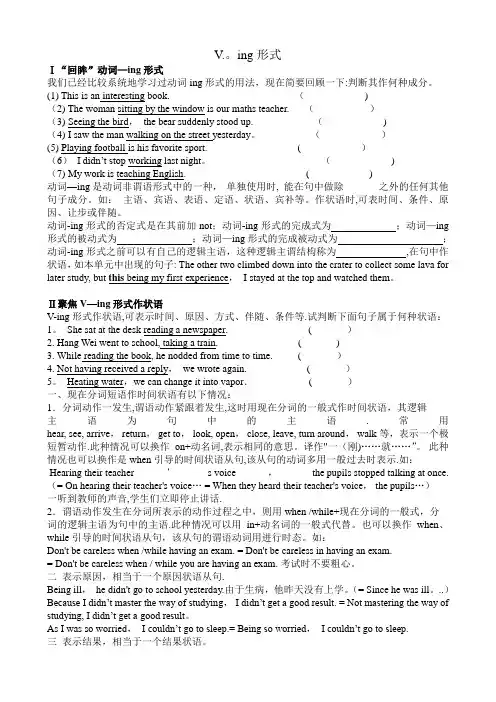
V.。
ing形式Ⅰ“回眸”动词—ing形式我们已经比较系统地学习过动词ing形式的用法,现在简要回顾一下:判断其作何种成分。
(1) This is an interesting book. ()(2) The woman sitting by the window is our maths teacher. ()(3) Seeing the bird,the bear suddenly stood up. ()(4) I saw the man walking on the street yesterday。
()(5) Playing football is his favorite sport. ( )(6)I didn’t stop working last night。
()(7) My work is teaching English. ( )动词—ing是动词非谓语形式中的一种,单独使用时, 能在句中做除_____ 之外的任何其他句子成分。
如:主语、宾语、表语、定语、状语、宾补等。
作状语时,可表时间、条件、原因、让步或伴随。
动词-ing形式的否定式是在其前加not;动词-ing形式的完成式为;动词—ing 形式的被动式为;动词—ing形式的完成被动式为;动词-ing形式之前可以有自己的逻辑主语,这种逻辑主谓结构称为,在句中作状语,如本单元中出现的句子: The other two climbed down into the crater to collect some lava for later study, but this being my first experience,I stayed at the top and watched them。
Ⅱ聚焦V—ing形式作状语V-ing形式作状语,可表示时间、原因、方式、伴随、条件等.试判断下面句子属于何种状语:1。
She sat at the desk reading a newspaper. ( )2. Hang Wei went to school, taking a train. ( )3. While reading the book, he nodded from time to time. ( )4. Not having received a reply,we wrote again. ( )5。

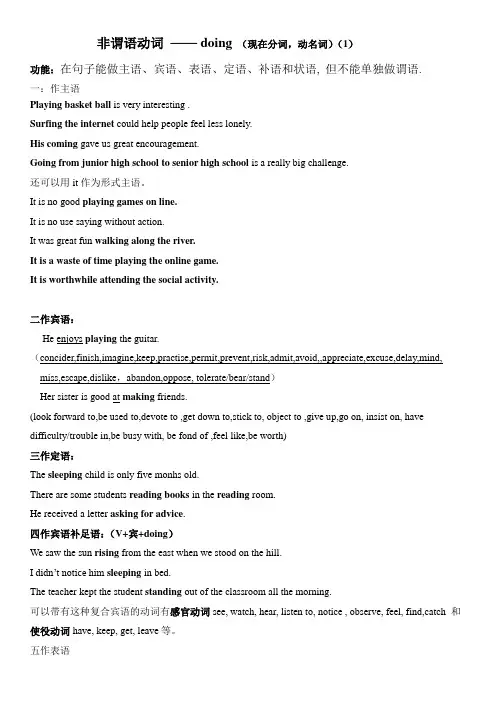
非谓语动词——doing(现在分词,动名词)(1)功能:在句子能做主语、宾语、表语、定语、补语和状语, 但不能单独做谓语.一:作主语Playing basket ball is very interesting .Surfing the internet could help people feel less lonely.His coming gave us great encouragement.Going from junior high school to senior high school is a really big challenge.还可以用it作为形式主语。
It is no good playing games on line.It is no use saying without action.It was great fun walking along the river.It is a waste of time playing the online game.It is worthwhile attending the social activity.二作宾语:He enjoys playing the guitar.(concider,finish,imagine,keep,practise,permit,prevent,risk,admit,avoid,,appreciate,excuse,delay,mind, miss,escape,dislike,abandon,oppose, tolerate/bear/stand)Her sister is good at making friends.(look forward to,be used to,devote to ,get down to,stick to, object to ,give up,go on, insist on, have difficulty/trouble in,be busy with, be fond of ,feel like,be worth)三作定语:The sleeping child is only five monhs old.There are some students reading books in the reading room.He received a letter asking for advice.四作宾语补足语:(V+宾+doing)We saw the sun rising from the east when we stood on the hill.I didn’t notice him sleeping in bed.The teacher kept the student standing out of the classroom all the morning.可以带有这种复合宾语的动词有感官动词see, watch, hear, listen to, notice , observe, feel, find,catch 和使役动词have, keep, get, leave等。
动词的ing形式作表语,定语,宾补和状语一、动词-ing形式作表语1. 表示主语的内容,可以转换到句首作主语Her job is keeping the lecture hall as clean as possible. (= keeping the lecture hall as clean as possible is her job)她的工作是尽量使报告厅保持干净。
2. 表示主语具有的特征、性质和状态(动词ing 相当一个形容词)The problem is quite puzzling.这个问题很令困惑。
3.常用来作表语的现在分词有astonishing, amusing, confusing, disappointing, boring, encouraging, inspiring, moving, tiring, interesting, surprising等。
全析提示:动词-ing形式作表语时,其逻辑主语往往是句子中的主语,但用作表语的-ing形式也可带有自己的逻辑主语。
What worries me most is her staying too late every night. (staying too late every night的逻辑主语是her)二、动词-ing形式作定语1 单个的动词-ing形式可以作前置定语,一般具有两种含义。
①说明被修饰名词的用途和性能。
a reading room = a room which is used for reading 阅览室running shoes =shoes for running 跑鞋a working method =a method for working 工作方法②表示所修饰的人或物的动作或状态,在意思上接近一个定语从句,可以表示正在进行的动作,也可表示经常性动作或当时的状态。
developing countries = countries that are developing发展中国家an ordinary-looking house = a house that looks ordinary看起来很普通的房子a puzzling problem = a problem that puzzles somebody困扰人的问题2 作定语的动词-ing形式如是一个短语,则应放在被修饰词的后面,做后置定语,相当于一个定语从句。
非谓语动词汇总一、Doing1、只能接V-ing的动词有:(V+doing,doing做宾语)1),Enjoy, finish, mind, can’t stand, be busy, keep(on), feel like, have fun/trouble/difficulty/problems in----, practice, finish, give up, consider, put off, suggest, miss imagine, can’t help be worth, avoid, miss, end up, allow, 2),Forgive, delay, escape,2,V+sb +doing(doing做宾补),这类V有:感官动词(包括find 和notice),there be, keep等3,动词做主语应用动名词形式,且后面的谓语动词用单数4,介词后如果接动词,应该用动名词形式。
尤其注意一些含有介词的一些词组,eg,1)what/how about----? have fun/trouble/difficulty/problems in----, insteadof, be good at=do well in, by+ doing sth, spend------(in) doing sth, feel like, get/be used to, prefer doing to doing, devote oneself to----致力于----,献身于----2) succeed in doing sth, be fond of, pay attention to, make a contributionto,devote oneself to--- , insist on,look forward to5, 1)动名词做定语。
放在名词前,说明该名词的功能或用途时,如swimming pool, living room, sleeping bag, hiding place等2)现在分词做定语。
非谓语动词用法解析动词ing作目的状语非谓语动词用法解析:动词-ing作目的状语动词-ing作目的状语是非谓语动词的一种常见用法。
在句子中,动词-ing形式可以作为目的状语,表示主语的动作或状态的目的或用途。
本文将对非谓语动词-ing作目的状语的用法进行详细解析。
一、形式动词-ing作目的状语的形式为动词的现在分词形式,即动词原形 + ing。
例如:1. I went shopping to buy some groceries.我去购物是为了买些杂货。
2. She stayed up late to finish her project.她熬夜是为了完成她的项目。
3. They studied hard to pass the exam.他们努力学习是为了通过考试。
二、用法1. 表示主语的目的或用途动词-ing作目的状语可以说明主语进行某个动作或处于某种状态的目的或用途。
例如:1. They traveled to experience different cultures.他们旅行是为了经历不同的文化。
2. The students worked hard to earn good grades.学生们努力学习是为了获得好成绩。
3. He went to the gym to build muscle.他去健身房是为了增肌肉。
2. 与动词不定式互换有些句子可以使用动词-ing作目的状语或动词不定式作目的状语,表示相同的意思。
这时候,动词-ing往往更常用于口语或非正式场合。
例如:1. He went to the store to buy milk. 或 He went to the store buying milk.他去商店是为了买牛奶。
2. She came to the party to meet new people. 或 She came to the party meeting new people.她来参加派对是为了结识新的人。
非谓语动词doing的固定搭配和句型1.There be +n+ v-ing 有…正在做某事by doing sth 通过做某事find+sb.+doing2.动名词短语作主语(一件事,谓语动词用单数)Studying grammar is a good way to learn a language3. 动名词表伴随Eg:1.The girl goes out of the classroom, singing and dancing.(一)只能用动名词作宾语的动词allow doing sth.can’t help doing sthcan’t stand doing sth.consider doing sth. 考虑做某事enjoy doing sth.finish doing sth.imagine doing sth.keep doing sth.miss doing sth.mind doing sth.practice doing sth.suggest doing sth.Would you mind doing sth?keep sb. doing sth.be worth doing sth.have fun doing sth.feel like doing sth.give up doing sth.put off doing sth.(二)、动名词作介词宾语1.be +adj.+ about doing sth.be careful about doing sth.How/what about doing sth?worry about doing sth.2.aim at doing sth.be good /bad at doing sth.3.be/get ready for doing sth.be suitable for doing sth.It’s time for doing sth.Thanks for doing sth.4.keep sb. from doing sth.prevent sb. from doing sth.stop sb from doing sth.5.有时in可以被省略。
语法复习——非谓语动词(一)动词-ing的用法非谓语动词主要包括动词-ing形式、过去分词和不定式。
为了区分这三种不同的非谓语动词的用法和含义,我们将分别从三种非谓语动词在句子中所作的成分以及一些特殊句型等角度来区分其用法和细微含义。
本讲主要阐述动词-ing形式的用法。
动词-ing形式起到名词、形容词和副词的作用,在句中可作主语、宾语和表语、状语和宾语补足语,但不能单独构成谓语。
“动词原形+ing”构成动词-ing形式可分为动名词和现在分词。
一、动名词动名词是v.–ing形式的一种,它具有名词特征,可在句子中作主语、宾语、表语。
1.动名词作主语的几种句型动名词直接置于句首作主语,动名词作主语可以是主动形式,也可以是被动形式。
例如: Swimming in winter is healthy. 冬泳是有益健康的运动。
Picking apples is much better than having classes. 摘苹果比上课好多了。
Being elected chairman is a great honor to him. 被选为主席对他是一个很大的荣誉。
有时主语太长,可用it作形式主语,将真正主语即动名词放在后面。
不是所有的动名词作主语都可用it作形式主语,常见的有: It is + no use+动名词做……没有用处 It is + no good +动名词做……没有好处 It is +nice+动名词做……很好/很不错 It is +useless +动名词做……没有用 It is +interesting+动名词做……很有趣 It is +dangerous+动名词做……很危险 It is+a waste of+动名词做……是浪费…… 例如:It is no use waiting here. Let’s walk home. 在这儿等着没有用,我们走回家吧。
It’s interesting watching the children play. 看着这些孩子们玩耍很有趣。
do homework1. Chen asked me 1. Chen asked me that I needed to do my work.2 The homework that Chen asked us to do is difficult.3. That I need to do my work everyday is boring.4.1. doingI am doing my homework now.Doing my homework cost me a lot of time. Doing my homework, I received your call.=When I was doing my work, I ….Doing homework is very time consuming.The man (who is) doing homework is Chen.I enjoy doing my homework.The falling leaves are interesting.This is a walking stick.This is a walking cat.2. being doneMy homework being done, I answered your call.The homework being done by Chen is difficult.I am appreciated being given an opportunity to study abroad.3. having doneHaving done his homework, Chen watched TV. =After he had done his homework, Chenwatched TV.I enjoy having given an opportunity to you to study abroad two years ago.4. having been doneHaving been done, my homework was checked by by Chen.I am appreciated having been given an opportunity to study abroad two years ago.5. to doI want to do my homework.To do my homework will cost me a lot of time. Chen is said to do the homework.6. to be doneThe homework to be done is difficult.The homework that will be done is difficult.The homework being done is difficult.done last week is difficult.China is reported to have won the competition last year.China was reported the competition last year.The home work to do is difficult.The building to be built at the end of this year is a gymnasium.The work is said to be done by Chen.7. to have doneChen is said to do the homework next week. Chen is said to have done the homework last week.8. to have been doneThe work is said to have been done by Chen last week. .9. doneThe Chen last week is/was important.The work done by Chen last week is/was important.= The Chen last week is/was important.Seen from the moon, the earth looks like a blue ball.Being seen from the moon, the earth looks like a blue ball.The fallen leaves are interesting.The falling leaves are interesting.I want to drink boiled/boiling water.。
非谓语动词doing的用法总结
非谓语动词doing的用法总结如下:
1. 做主语:Doing exercises regularly helps improve physical fitness.
经常做运动有助于提高身体健康。
2. 做宾语:I enjoy doing yoga.
我喜欢做瑜伽。
3. 做定语:A living room is a place for doing various activities.
客厅是进行各种活动的地方。
4. 做补语:He kept on doing the same mistake.
他一直在犯着同样的错误。
5. 做状语:She left, doing her best to hide her tears.
她离开时,竭尽全力掩饰自己的眼泪。
6. 做同位语:Her favorite hobby, doing crossword puzzles, keeps her mind sharp.
她最喜欢的爱好——填字游戏,使她的头脑保持敏锐。
7. 做宾语补足语:We found him sitting alone in the park.
我们发现他独自坐在公园里。
总结:非谓语动词doing可以在句子中充当主语、宾语、定语、补语、状语、同位语以及宾语补足语的角色。